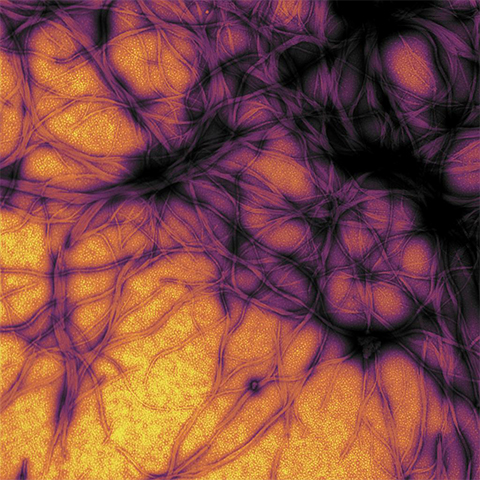Strategies for protein quality control
Proteins bear the burden of keeping our cells and bodies functioning normally. To do this job, each protein must fold into a unique structure. However, newly formed proteins sometimes misfold and aggregate, resulting in harmful or lost function.
Protein misfolding can cause human diseases such as cancer and cystic fibrosis and neurogenerative disorders such as Alzheimer’s, Parkinson’s and Huntington’s diseases.

Per Widlund and his team at the University of Gothenburg study the cellular processing of misfolded proteins. “Proteins are major structural and functional components of cells,” Widlund said. “Like the components of any well-used machine, parts need to be constantly replaced with new ones to prevent breakdown.”
The process of proteostasis ensures that proteins are built correctly, maintained, delivered to cellular locations and recycled if they become too damaged to do their job properly. “Cells accomplish proteostasis with an intricate protein quality control network that ensures proteins achieve and maintain a functional state,” Widlund said.
The two arms of the protein quality control network work together to prevent the toxic effects of misfolding. The spatial arm segregates misfolded protein aggregates into protective sites called inclusion bodies. The temporal arm ensures the accurate folding of new proteins, refolding of aberrant proteins and degradation of misfolded proteins by the ubiquitin-proteasome or vacuole-autophagy pathways.
“To combat protein misfolding diseases, we need to understand why the aggregates build up and how the failure to clear them is related to toxicity,” Widlund said. “In other words: why are some misfolding proteins toxic while others are not?”
In a recent study published in the Journal of Biological Chemistry, Widlund and his team established a system, using yeast as a model, to study protein quality control mechanisms that clear misfolded proteins.
The new model system uses three temperature-sensitive nontoxic mutants of three proteins that misfold at 38 degrees Celsius with known differences in aggregate removal rates. The mutants, produced continuously in the cells, do not affect normal functioning or the lifespan of yeast cells, allowing the researchers to study the fundamental mechanisms of aggregation and clearance.
“We compared how three different misfolding proteins are processed and found that their ability to recruit protein quality control components and their removal varied,” Widlund said. “Each misfolding protein’s specific characteristics play a significant role in its processing, allowing certain proteins to evade protein quality control, potentially leading to toxicity and disease.”
Using a combination of time-lapse microscopy, structured illumination, microscopy and electron microscopy as well as proteasome degradation and clearance assays, the team found that all the misfolded reporter proteins accumulated into aggregates in the same cellular compartments. However, their disaggregation efficiencies varied.
“We hypothesized that different misfolding proteins contained in the same aggregate would impact each other more,” Widlund said. “We were surprised to see that one misfolding protein did not affect the removal of another, at least in young, healthy cells.”
Of the three mutants studied, cells cleared misfolded glutamyl-tRNA synthetase less efficiently compared to the other two. And while all three mutants localized in the same cellular compartments, a small percentage of misfolded glutamyl-tRNA synthetase also accumulated in mitochondria. The cells most rapidly cleared misfolded delta 1-pyrroline-5-carboxylate reductase. The authors also report differences in the recruitment of proteasomes by these misfolded proteins.
“The next step is to examine aged cells,” Widlund said, “and see if this holds for other, more toxic, misfolding proteins.”
Enjoy reading ASBMB Today?
Become a member to receive the print edition four times a year and the digital edition monthly.
Learn moreGet the latest from ASBMB Today
Enter your email address, and we’ll send you a weekly email with recent articles, interviews and more.
Latest in Science
Science highlights or most popular articles

Bacteriophage protein could make queso fresco safer
Researchers characterized the structure and function of PlyP100, a bacteriophage protein that shows promise as a food-safe antimicrobial for preventing Listeria monocytogenes growth in fresh cheeses.

Building the blueprint to block HIV
Wesley Sundquist will present his work on the HIV capsid and revolutionary drug, Lenacapavir, at the ASBMB Annual Meeting, March 7–10, in Maryland.

Gut microbes hijack cancer pathway in high-fat diets
Researchers at the Feinstein Institutes for Medical Research found that a high-fat diet increases ammonia-producing bacteria in the gut microbiome of mice, which in turn disrupts TGF-β signaling and promotes colorectal cancer.

Mapping fentanyl’s cellular footprint
Using a new imaging method, researchers at State University of New York at Buffalo traced fentanyl’s effects inside brain immune cells, revealing how the drug alters lipid droplets, pointing to new paths for addiction diagnostics.

Designing life’s building blocks with AI
Tanja Kortemme, a professor at the University of California, San Francisco, will discuss her research using computational biology to engineer proteins at the 2026 ASBMB Annual Meeting.

Cholesterol as a novel biomarker for Fragile X syndrome
Researchers in Quebec identified lower levels of a brain cholesterol metabolite, 24-hydroxycholesterol, in patients with fragile X syndrome, a finding that could provide a simple blood-based biomarker for understanding and managing the condition.

